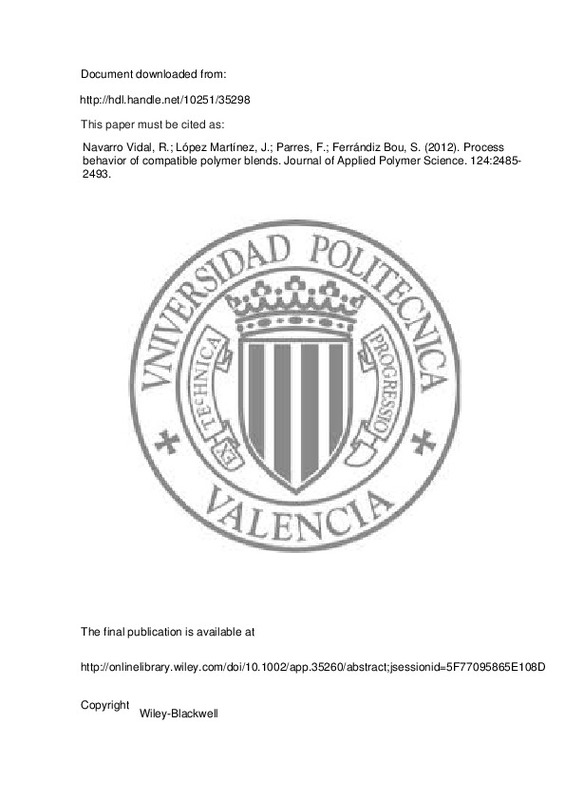Lucchetta, G., Bariani, P. F., & Knight, W. A. (2006). A New Approach to the Optimization of Blends Composition in Injection Moulding of Recycled Polymers. CIRP Annals, 55(1), 465-468. doi:10.1016/s0007-8506(07)60460-0
Navarro, R., Ferrándiz, S., López, J., & Seguí, V. J. (2008). The influence of polyethylene in the mechanical recycling of polyethylene terephtalate. Journal of Materials Processing Technology, 195(1-3), 110-116. doi:10.1016/j.jmatprotec.2007.04.126
Frigione, M. (2010). Recycling of PET bottles as fine aggregate in concrete. Waste Management, 30(6), 1101-1106. doi:10.1016/j.wasman.2010.01.030
[+]
Lucchetta, G., Bariani, P. F., & Knight, W. A. (2006). A New Approach to the Optimization of Blends Composition in Injection Moulding of Recycled Polymers. CIRP Annals, 55(1), 465-468. doi:10.1016/s0007-8506(07)60460-0
Navarro, R., Ferrándiz, S., López, J., & Seguí, V. J. (2008). The influence of polyethylene in the mechanical recycling of polyethylene terephtalate. Journal of Materials Processing Technology, 195(1-3), 110-116. doi:10.1016/j.jmatprotec.2007.04.126
Frigione, M. (2010). Recycling of PET bottles as fine aggregate in concrete. Waste Management, 30(6), 1101-1106. doi:10.1016/j.wasman.2010.01.030
Sánchez-Soto, M., Rossa, A., Sánchez, A. J., & Gámez-Pérez, J. (2008). Blends of HDPE wastes: Study of the properties. Waste Management, 28(12), 2565-2573. doi:10.1016/j.wasman.2007.10.010
Clavería, I., Javierre, C., & Ponz, L. (2005). Method for generation of rheological model to characterize non-conventional injection molding by means of spiral mold. Journal of Materials Processing Technology, 162-163, 477-483. doi:10.1016/j.jmatprotec.2005.02.065
Bariani, P. F., Salvador, M., & Lucchetta, G. (2007). Development of a test method for the rheological characterization of polymers under the injection molding process conditions. Journal of Materials Processing Technology, 191(1-3), 119-122. doi:10.1016/j.jmatprotec.2007.03.089
Scaffaro, R., & La Mantia, F. P. (2002). Characterization of monopolymer blend of virgin and recycled polyamide 6. Polymer Engineering & Science, 42(12), 2412-2417. doi:10.1002/pen.11127
Javierre, C., Clavería, I., Ponz, L., Aísa, J., & Fernández, A. (2007). Influence of the recycled material percentage on the rheological behaviour of HDPE for injection moulding process. Waste Management, 27(5), 656-663. doi:10.1016/j.wasman.2006.03.005
Boronat, T., Segui, V. J., Peydro, M. A., & Reig, M. J. (2009). Influence of temperature and shear rate on the rheology and processability of reprocessed ABS in injection molding process. Journal of Materials Processing Technology, 209(5), 2735-2745. doi:10.1016/j.jmatprotec.2008.06.013
Kukaleva, N., Simon, G. P., & Kosior, E. (2003). Modification of recycled high-density polyethylene by low-density and linear-low-density polyethylenes. Polymer Engineering & Science, 43(1), 26-39. doi:10.1002/pen.10002
Bagley, E. B. (1957). End Corrections in the Capillary Flow of Polyethylene. Journal of Applied Physics, 28(5), 624-627. doi:10.1063/1.1722814
Shenoy, A. V., & Saini, D. R. (1984). Rheological models for unified curves for simplified design calculations in polymer processing. Rheologica Acta, 23(4), 368-377. doi:10.1007/bf01329189
Chowdhury, R., Banerji, M. S., & Shivakumar, K. (2007). Polymer blends of carboxylated butadiene-acrylonitrile copolymer (nitrile rubber) and polyamide 6 developed in twin screw extrusion. Journal of Applied Polymer Science, 104(1), 372-377. doi:10.1002/app.24858
Peltzer, M., Navarro, R., López, J., & Jiménez, A. (2010). Evaluation of the melt stabilization performance of hydroxytyrosol (3,4-dihydroxy-phenylethanol) in polypropylene. Polymer Degradation and Stability, 95(9), 1636-1641. doi:10.1016/j.polymdegradstab.2010.05.021
Pospı́šil, J., Horák, Z., Pilař, J., Billingham, N. ., Zweifel, H., & Nešpůrek, S. (2003). Influence of testing conditions on the performance and durability of polymer stabilisers in thermal oxidation. Polymer Degradation and Stability, 82(2), 145-162. doi:10.1016/s0141-3910(03)00210-6
Hernández, R., Peña, J. J., Irusta, L., & Santamarı́a, A. (2000). The effect of a miscible and an immiscible polymeric modifier on the mechanical and rheological properties of PVC. European Polymer Journal, 36(5), 1011-1025. doi:10.1016/s0014-3057(99)00146-9
Kola?�ak, J., Fambri, L., Pegoretti, A., Penati, A., & Goberti, P. (2002). Prediction of the creep of heterogeneous polymer blends: Rubber-toughened polypropylene/poly(styrene-co-acrylonitrile). Polymer Engineering & Science, 42(1), 161-169. doi:10.1002/pen.10937
Quintanilla, J. (1999). Microstructure and properties of random heterogeneous materials: A review of theoretical results. Polymer Engineering & Science, 39(3), 559-585. doi:10.1002/pen.11446
Greco, R., & Iavarone, M. (2000). Influence of low molecular weight ABS species on properties of PC/ABS systems. Polymer Engineering & Science, 40(7), 1701-1715. doi:10.1002/pen.11302
Kola?�k, J., Fambri, L., Pegoretti, A., & Penati, A. (2000). Prediction of the gas permeability of heterogeneous polymer blends. Polymer Engineering & Science, 40(1), 127-131. doi:10.1002/pen.11145
Robeson, L. M., & Berner, R. A. (2001). Mechanical properties of emulsion polymer blends. Journal of Polymer Science Part B: Polymer Physics, 39(11), 1093-1106. doi:10.1002/polb.1086
Silva, A. L. N., Rocha, M. C. G., & Coutinho, F. M. B. (2002). Study of rheological behavior of elastomer/polypropylene blends. Polymer Testing, 21(3), 289-293. doi:10.1016/s0142-9418(01)00084-8
[-]







![[Cerrado]](/themes/UPV/images/candado.png)


